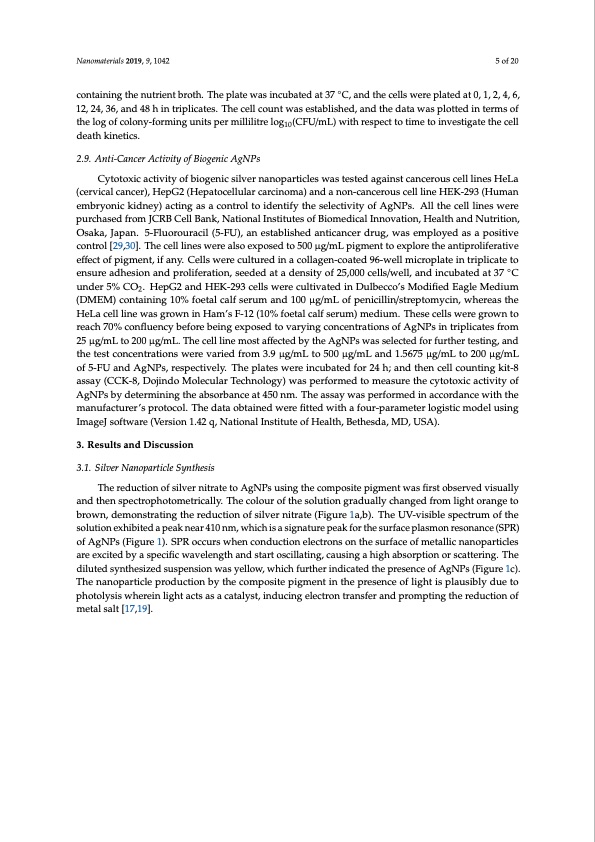
PDF Publication Title:
Text from PDF Page: 005
Nanomaterials 2019, 9, 1042 5 of 20 containing the nutrient broth. The plate was incubated at 37 ◦C, and the cells were plated at 0, 1, 2, 4, 6, 12, 24, 36, and 48 h in triplicates. The cell count was established, and the data was plotted in terms of the log of colony-forming units per millilitre log10(CFU/mL) with respect to time to investigate the cell death kinetics. 2.9. Anti-Cancer Activity of Biogenic AgNPs Cytotoxic activity of biogenic silver nanoparticles was tested against cancerous cell lines HeLa (cervical cancer), HepG2 (Hepatocellular carcinoma) and a non-cancerous cell line HEK-293 (Human embryonic kidney) acting as a control to identify the selectivity of AgNPs. All the cell lines were purchased from JCRB Cell Bank, National Institutes of Biomedical Innovation, Health and Nutrition, Osaka, Japan. 5-Fluorouracil (5-FU), an established anticancer drug, was employed as a positive control [29,30]. The cell lines were also exposed to 500 μg/mL pigment to explore the antiproliferative effect of pigment, if any. Cells were cultured in a collagen-coated 96-well microplate in triplicate to ensure adhesion and proliferation, seeded at a density of 25,000 cells/well, and incubated at 37 ◦C under 5% CO2. HepG2 and HEK-293 cells were cultivated in Dulbecco’s Modified Eagle Medium (DMEM) containing 10% foetal calf serum and 100 μg/mL of penicillin/streptomycin, whereas the HeLa cell line was grown in Ham’s F-12 (10% foetal calf serum) medium. These cells were grown to reach 70% confluency before being exposed to varying concentrations of AgNPs in triplicates from 25 μg/mL to 200 μg/mL. The cell line most affected by the AgNPs was selected for further testing, and the test concentrations were varied from 3.9 μg/mL to 500 μg/mL and 1.5675 μg/mL to 200 μg/mL of 5-FU and AgNPs, respectively. The plates were incubated for 24 h; and then cell counting kit-8 assay (CCK-8, Dojindo Molecular Technology) was performed to measure the cytotoxic activity of AgNPs by determining the absorbance at 450 nm. The assay was performed in accordance with the manufacturer’s protocol. The data obtained were fitted with a four-parameter logistic model using ImageJ software (Version 1.42 q, National Institute of Health, Bethesda, MD, USA). 3. Results and Discussion 3.1. Silver Nanoparticle Synthesis The reduction of silver nitrate to AgNPs using the composite pigment was first observed visually and then spectrophotometrically. The colour of the solution gradually changed from light orange to brown, demonstrating the reduction of silver nitrate (Figure 1a,b). The UV-visible spectrum of the solution exhibited a peak near 410 nm, which is a signature peak for the surface plasmon resonance (SPR) of AgNPs (Figure 1). SPR occurs when conduction electrons on the surface of metallic nanoparticles are excited by a specific wavelength and start oscillating, causing a high absorption or scattering. The diluted synthesized suspension was yellow, which further indicated the presence of AgNPs (Figure 1c). The nanoparticle production by the composite pigment in the presence of light is plausibly due to photolysis wherein light acts as a catalyst, inducing electron transfer and prompting the reduction of metal salt [17,19].PDF Image | Biosynthesis of Silver Nanoparticles Talaromyces purpurogenus

PDF Search Title:
Biosynthesis of Silver Nanoparticles Talaromyces purpurogenusOriginal File Name Searched:
nanomaterials-09-01042.pdfDIY PDF Search: Google It | Yahoo | Bing
Turbine and System Plans CAD CAM: Special for this month, any plans are $10,000 for complete Cad/Cam blueprints. License is for one build. Try before you buy a production license. More Info
Waste Heat Power Technology: Organic Rankine Cycle uses waste heat to make electricity, shaft horsepower and cooling. More Info
All Turbine and System Products: Infinity Turbine ORD systems, turbine generator sets, build plans and more to use your waste heat from 30C to 100C. More Info
CO2 Phase Change Demonstrator: CO2 goes supercritical at 30 C. This is a experimental platform which you can use to demonstrate phase change with low heat. Includes integration area for small CO2 turbine, static generator, and more. This can also be used for a GTL Gas to Liquids experimental platform. More Info
Introducing the Infinity Turbine Products Infinity Turbine develops and builds systems for making power from waste heat. It also is working on innovative strategies for storing, making, and deploying energy. More Info
Need Strategy? Use our Consulting and analyst services Infinity Turbine LLC is pleased to announce its consulting and analyst services. We have worked in the renewable energy industry as a researcher, developing sales and markets, along with may inventions and innovations. More Info
Made in USA with Global Energy Millennial Web Engine These pages were made with the Global Energy Web PDF Engine using Filemaker (Claris) software.
Infinity Turbine Developing Spinning Disc Reactor SDR or Spinning Disc Reactors reduce processing time for liquid production of Silver Nanoparticles.
| CONTACT TEL: 608-238-6001 Email: greg@infinityturbine.com | RSS | AMP |